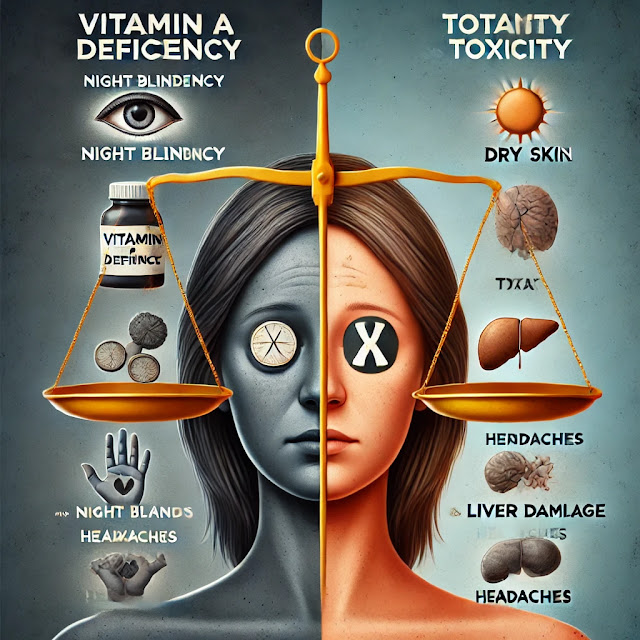The Comprehensive Guide to Vitamin A: Benefits, Sources, and Its Vital Roles in Vision, Immunity, Skin Health, and Cellular Function
Vitamin A is one of the most essential nutrients for maintaining overall health, yet its multifaceted roles are often overlooked. From enabling night vision to bolstering immune defenses, promoting youthful skin, and ensuring proper cellular growth, this fat-soluble vitamin is a cornerstone of human biology. In this in-depth guide, we’ll explore the science-backed benefits of vitamin A, its mechanisms of action, dietary sources, and the risks of deficiency or excess—all optimized for the keyword “vitamin A” to help you unlock its full potential.
1. Vitamin A and Vision: How It Powers Night Vision and Prevents Blindness
Vitamin A’s most celebrated role is in vision, particularly night vision. Here’s a deep dive into how it works:
The Biochemistry of Vision
Rhodopsin: The Light-Sensing Pigment
Rhodopsin, a protein-pigment complex in the retina’s rod cells, is critical for low-light vision. It consists of opsin (a protein) bound to 11-cis-retinal, a vitamin A derivative. When light hits the retina, rhodopsin splits into opsin and all-trans-retinal, triggering a nerve impulse to the brain that enables sight.Recycling Retinal for Continuous Vision
After light exposure, all-trans-retinal is converted back to 11-cis-retinal in a process requiring vitamin A. Without adequate vitamin A stores, this regeneration slows, leading to night blindness (nyctalopia).
Deficiency and Eye Health
Night Blindness: Early deficiency manifests as difficulty seeing in dim light. Ancient Egyptian texts describe treating night blindness with animal liver—a rich source of vitamin A.
Xerophthalmia: Severe deficiency causes dryness, corneal ulcers, and irreversible blindness. The World Health Organization (WHO) estimates that 250,000–500,000 children go blind annually due to vitamin A deficiency.
Beyond Night Vision
Vitamin A also supports:
Color Vision: Cones in the retina (responsible for color detection) rely on similar photopigments.
Corneal Health: It maintains the cornea’s transparency and moisture.
2. Vitamin A and Immune Function: Your Body’s First Line of Defense
Vitamin A is often called the “anti-infective vitamin” for its critical role in immune resilience.
Strengthening Physical Barriers
Mucous Membranes: Vitamin A maintains epithelial cells in the respiratory, digestive, and urinary tracts. These cells produce mucus that traps pathogens like bacteria and viruses.
Skin Integrity: By regulating keratin production, vitamin A prevents cracks in the skin that could allow infections.
Cellular Immunity: White Blood Cell Regulation
T-Cells and B-Cells: Vitamin A enhances the differentiation of T-lymphocytes (which destroy infected cells) and B-lymphocytes (which produce antibodies).
Macrophages and Neutrophils: These frontline immune cells rely on vitamin A to efficiently phagocytose (engulf) pathogens.
Vitamin A Deficiency and Infection Risk
Deficiency weakens mucosal barriers and reduces immune cell activity, increasing susceptibility to:
Measles and diarrhea (a leading cause of child mortality in developing nations).
Respiratory infections like pneumonia.
The WHO recommends high-dose vitamin A supplements for children in high-risk regions to cut mortality rates by 24%.
3. Vitamin A for Skin Health: Anti-Aging, Acne Relief, and Beyond
Vitamin A’s impact on skin is so profound that its derivatives (retinoids) dominate dermatology.
How Vitamin A Renews Skin
Cell Turnover Acceleration: Retinoids stimulate basal keratinocytes to divide, shedding dead skin cells and revealing fresher layers. This reduces wrinkles, hyperpigmentation, and rough texture.
Collagen Boost: Vitamin A activates fibroblasts to produce collagen, improving skin elasticity and reducing sagging.
Sebum Regulation
: Normalizing oil gland activity, it helps prevent acne.
Clinical Applications
Acne Treatment: Prescription retinoids like tretinoin unclog pores and reduce inflammation.
Psoriasis and Eczema: Vitamin A modulates skin cell growth to alleviate scaling and redness.
Photoaging: Topical retinol creams reverse sun damage by repairing DNA in skin cells.
Diet vs. Topical Use
While topical retinoids target surface layers, dietary vitamin A (e.g., sweet potatoes, spinach) supports deeper skin health by reducing oxidative stress and inflammation.
4. Vitamin A and Cellular Growth: From Embryos to Tissue Repair
Vitamin A’s role in cellular processes is foundational to life itself.
Gene Expression and Differentiation
Retinoic Acid Receptors (RARs): Vitamin A binds to nuclear receptors, directly influencing gene transcription. This regulates:
Embryogenesis: Critical for heart, lung, and nervous system development in fetuses. Deficiencies during pregnancy can cause birth defects like cleft palate.
Stem Cell Differentiation: Guides stem cells to become specialized cells (e.g., red blood cells, epithelial cells).
Tissue Repair and Cancer Prevention
Wound Healing: Vitamin A promotes angiogenesis (new blood vessel formation) and collagen synthesis at injury sites.
Apoptosis Regulation Helps eliminate precancerous cells by triggering programmed cell death. Studies link adequate vitamin A intake to reduced risks of lung and skin cancers.
Reproductive Health
Spermatogenesis: Vitamin A supports sperm development in males.
Placental Health: In females, it ensures proper nutrient transfer to the fetus.
5. Dietary Sources of Vitamin A: Animal vs. Plant-Based Options
Vitamin A exists in two primary forms:
Preformed Vitamin A (Retinol): Found in animal products like liver, eggs, and dairy.
Provitamin A Carotenoids (Beta-Carotene): Plant pigments in carrots, spinach, and mangoes that convert to retinol in the body.
Top Food Sources
Animal-Based:
Beef liver (1 slice: 6,582 mcg RAE, 730% DV).
Salmon (100g: 149 mcg RAE, 17% DV).
Plant-Based:
Sweet potato (1 cup: 1,836 mcg RAE, 204% DV).
Kale (1 cup: 443 mcg RAE, 49% DV).
Absorption Tips
Pair carotenoid-rich foods with healthy fats (e.g., olive oil) to enhance absorption.
Cooking vegetables like tomatoes and carrots breaks down cell walls, releasing more beta-carotene.
6. Vitamin A Deficiency vs. Toxicity: Striking the Balance
Deficiency Symptoms
Early Signs: Night blindness, dry skin, frequent infections.
Severe Cases: Corneal ulcers, stunted growth in children, infertility.
Toxicity Risks (Hypervitaminosis A)
Acute Toxicity: Nausea, dizziness, and blurred vision from single high doses (>200,000 mcg).
Chronic Toxicity: Bone pain, liver damage, and birth defects from prolonged excess intake.
Safe Upper Limits:
Adults: 3,000 mcg RAE/day.
Pregnant women: Avoid supplements exceeding 1,500 mcg RAE.
7. Frequently Asked Questions About Vitamin A
Q: Can vitamin A improve acne?
A: Yes! Prescription retinoids like isotretinoin reduce severe acne by 90% in most cases.
Q: Are vegan diets deficient in vitamin A?
A: Not if they include beta-carotene-rich foods like sweet potatoes and leafy greens.
Q: Does vitamin A interact with medications?
A: Yes. Avoid high doses if taking blood thinners (e.g., warfarin) or retinoid-based acne drugs.
Conclusion: Harnessing the Power of Vitamin A
Vitamin A is a nutritional powerhouse, indispensable for vision, immunity, radiant skin, and cellular vitality. By incorporating diverse sources—like liver, carrots, and spinach—into your diet, you can safeguard against deficiency while avoiding toxicity. Whether you’re looking to sharpen night vision, fend off infections, or maintain youthful skin, understanding and optimizing your vitamin A intake is a proven path to long-term health.





